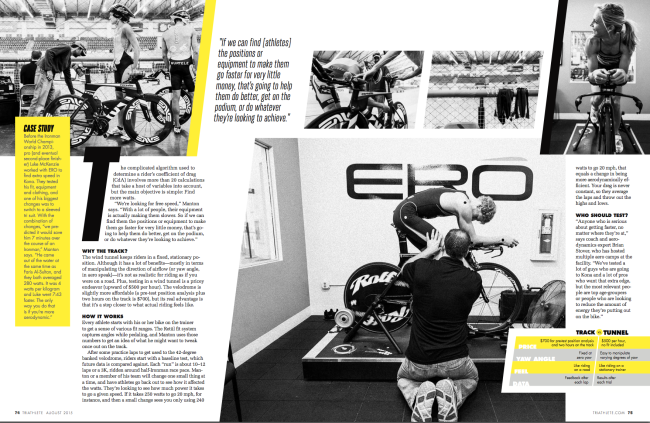

Triathlete Magazine
Art Director: Lisa Williams
Photo Editor: John David Becker
Graphic Designer: Olive Baker
Senior Editor/Writer: Jené Shaw
Photographer: Matt Harbicht
With such a big space and not much available light, what was your plan?
I knew we had enough lighting to really light up the corner with the track logo staring out. We were shooting that setup with the idea that it would make a great double page opener if they ran the horizontal or a great vertical Table of Contents (which is where it ran). The bulk of the spread was shot with the broadcast lights on during the track trials. That gave us just enough light to shoot higher ISO handheld. We also found a corner of the grandstands that would be tucked away from the rest of our shots where we could set up a small portrait studio for the rider profiles.
Is B/W a departure for the magazine? It works great with training images since the equipment and the kits are riddled with logos. Did you plan on BW the entire time?
I can’t remember seeing a full B&W story in Triathlete before. I know that magazine has run B&W shots in the past, but nothing like this. I thought it would definitely be a departure for the magazine, but I also thought it would be great if they ran with it. B&W wasn’t my plan going into it, but it was a solution to our first setup. Our first shots took place in the motion capture room and would involve having the riders on the bike trainer in a fairly small space. Taking the time to light those shots would’ve interfered with what they were doing and just gotten the day off to a rough start. I converted some of the first few shots to B&W and showed our Senior Editor/Writer Jené Shaw who was on set with us that day and emailed our Art Director Lisa Williams (who was back in the office) samples throughout the day so we were all on the same page.
I know you were a runner and now you’re into cycling. Is that why you were awarded the job?
Not originally. I got this particular job because I had shot for the magazine in the past and their staff photographer (John David Becker) got really sick the day before the shoot. They contacted me to fill in, because they already had a relationship with me and I was located near where the job had to be shot. So my interest in cycling didn’t land me this job specifically.
Are you finding that it’s important to actually understand the culture of a specific sport in order to land an assignment?
I don’t know if it’s necessary, but it can’t hurt your chances. I was told that I got one of my first jobs with Competitor Group, Inc (Triathlete’s Publisher) because they wanted someone with an endurance sport background to be able to talk shop with the athletes. In the years since that first job I’ve become much more interested in cycling and triathlon because of my involvement with the magazine. I think my interest and understanding of cycling helped me make better images for sure! If you’re excited about what you are shooting, it shows! In my case it helped me land that initial job and I think it’s great way to keep up relationships with the publications, especially specific sports markets like triathlon or running.
What do you think your excitement for road riding brought to the table?
Just that, excitement. I love cycling and although I haven’t started measuring my watts on rides like the pro riders we had in the feature, I’m just excited to mix two loves of mine ie: photography and cycling. I had never been to a Velodrome track let alone shoot on one so I was excited from the get go to be shooting in such a great location.
How long did the shoot take?
We had about 30 minutes per rider while they were tracking the bikes on the trainer, and then about 90 minutes so per rider while they were on the track. It was enough time to get the shots we needed of them riding, but a lot of the story was about the techs at ERO figuring out what they could do to make the riders faster and more efficient. We had a small side setup tucked out of the way to shoot rider portraits, so we got each rider for a few minutes as they were leaving. From load-in to tail-lights we shot from 8am to 3:30-4ish. I’m incredibly happy with the amount and variety of content we got in under a 10-hour day!
How many laps did they do until you got the perfect shot?
They would run in 3-4 laps per adjustment they made to the bikes or their kit so I would get one shot per lap. All in all, I think we got 10-15 “keepers” per rider on our lit up corner shot. We lit it in such a way that I could shoot it wide in profile, or straight on with a longer lens. In some instances, I even had enough time to switch positions during a lap. That way the magazine had some variation on the shots.
Who had the highest numbers of watts for the lap?
Honestly, I was so focused on getting our shot list and avoiding getting run over (I was laying down on the track really close to the riders for some of these shots) that I never found out! I do know that Eric Lagerstrom won the Escape from Alcatraz Tri a month or so after his ERO test and fitting!


